
Namaste. Over the years I have learnt often through my own hard experiences, the importance of safely trekking in Nepal as any instance could quickly turn into a dangerous situation particularly in remote mountains and the wild.
Here are some safety tips while trekking in the Himalayas in Nepal. Google around to find other travelers tips too. Meanwhile you can also read some of my trekking diaries here.
- Many trails in Nepal have mules /donkeys as main transport vehicles. If you see mules/donkeys coming towards you, make sure you always give side on the safe end. Don’t ever stand towards the edge of a cliff to let them pass, i.e stand on the side of the cliff wall. Mules/ donkeys will not hesitate to push you off the edge as they usually (obviously) want to take the safest side in the trail!
- Use walking sticks ( two if possible). it helps ease your balance and in some tricky situations like crossing streams or on broken paths. Trails usually go from good to worse within a day of change in weather. Sticks are a special help to your legs. You can find a pair at an affordable price in any trekking gear shops.
- Don’t hesitate to politely ask fellow traveller who are coming from opposite directions on the status of the trails and where there could be potential difficulty in passing through.
- If you are alone or with only one companion, always tag along trekking groups. This helps you when you chance upon a difficult situations when even small landslides, streams on paths cause you to walk carefully (often with the group’s guidance). Don’t hesitate to use your hands on difficult places. They are most handy. Don’t forget them. 🙂
- Make sure your shoes are in good condition, specially the soles. Carrying a super glue helps to glue in soles that might come off in these grueling walks. Water proof /resistant shoes are a good investment.
- In suspension bridges (you will run across plenty), don’t walk looking down deep into the gorges. It’s usually dizzying. Look straight ahead. if there are mules/donkeys crossing the bridge from the other direction, stop right there and go back out of the bridge! Let the mules/donkeys pass entirely before you step on to that bridge ! I told you so!
- Be extra careful walking downhill than uphill specially in cliffs. Slower is better. Sticks help a lot here. If you want to watch the scenery, stop and watch. I would warn you not to walk and watch the beautiful scenery around you at the same time while on a steep cliff. Just stop walking and enjoy at that instant.
- Watch your head! (when you are going to toilets, homestays, kitchens, gumbas as many of the traditional doors were built for people less than 6 feet (1.8 meters tall).
- If you are worried about the weather affecting your tightly scheduled travel, you can carry a satellite phone as there are no reliable warning systems in many villages up behind the mountains. A solar charger is best as there is plenty of “strong” sunshine during the day. Many villages near the mountains specially on trails outside the Everest and the Annapurna region do not get reliable electricity during the day.
- Always leave a day or two extra when you are trekking for more than a week or two. Most accidents happen because we are strapped for time and want to rush the trek which is dangerous in remote, high altitude regions. Be aware of altitude sickness above 3000 meters. Experts recommend not to climb more than 300 meters a day when above this altitude. I have myself had to stop myself on one occasion. And usually the most fit amongst the trekkers fall victim to this overconfidence’ and even lose their lives when not following this simple rule.
Nepal is a heaven when it comes to traveling through pristine beauty of nature and soul warming beauty of the locals you meet on the way.
My warm wishes for your soul cleansing journey safely in the wonders of Nepal!
Travel Safely ! (If you have your own travel tips, do add them in comments).
Meanwhile you can also read some of my trekking diaries here.